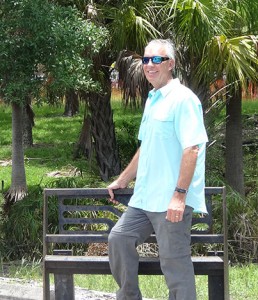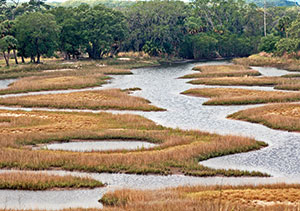
Photo by Victoria Parsons
Tom Ries is a perfect example of the second category. He earns a living as vice president and principal scientist at Scheda Ecological Services where he works on restoration projects ranging from Cockroach Bay and Robinson Preserve to the award-winning Schultz Park Nature Preserve and MacDill Air Force Base (see related story).
For fun, he established the non-profit Ecosphere Restoration Institute, where he leverages grants from local, state and national organizations to create partnerships that restore habitat in places like the Lost River Preserve, Newman Branch and Ulele Springs (see related story).
“There’s not much difference between what I do for work and what I do for fun – except the fun jobs are even more work because I have to raise the money to make it happen,” he says.
His dedication to restoring natural systems was recognized earlier this year with one of the nation’s most prestigious awards – the 2013 National Wetlands Award for Conservation & Restoration from the Environmental Law Institute.
“I didn’t even know I’d been nominated until I found out I won,” he says. “Everybody kept it a secret because it usually takes five or six nominations before you actually win – no one ever wins the first time.”
And the best thing about winning the national award: “I’ll have a lot more credibility for my next project.”
The second-best thing about winning: Reading the letters of recommendation from people he’s worked with over the years. “Even if I never won anything, just realizing how much people respect my work is amazing,” he says.
“Within the restoration community, Tom is known specifically for his ability to bring public and private partners to the table, ingenuity in restoration design, dedication to wildlife resources and a desire for community participation and stewardship,” writes Nicole Adimey, Tampa Bay program coordinator for the U.S. Fish and Wildlife Service, who submitted the winning nomination.
“I believe Tom is the face and vision of wetland restoration in southwest Florida,” adds Marti McGuire, assistant program manager for NOAA Fisheries Service. “Tom has led the identification, prioritization, design, and implementation of projects and initiatives that have restored thousands of acres of critical wetland habitat around Tampa Bay.”

Photo by Nanette O’Hara
One of the keys to Tom’s success is his ability to bring public and private partners to the table to design and implement innovative and cost-saving projects. “Tom has championed the development and implementation of public-private partnerships to perform restoration projects,” says Brandt Henningsen, chief environmental scientist for the Southwest Florida Water Management District. “This approach has significant benefits for the future of Tampa Bay and for the public that uses the resource.”
For example, a public-private partnership Ries initiated to restore estuarine and freshwater wetlands at Newman Branch Creek brought together Tampa Electric Company (TECO) and the SWFWMD (read his column in the Fall 2012 issue of Bay Soundings), resulting in a highly successful project that won the Hillsborough County Planning Commission’s top environmental award. “This project has become a model for future restoration projects, especially where available public land is scarce,” says Lindsay Cross, environmental science and policy manager at the Tampa Bay Estuary Program.
Phase II of Newman Branch is underway now, with TECO actually purchasing lands for expansion rather than using property it already owned for restoration.
Ries also spearheaded the restoration of Lost River Preserve through his not-for-profit organization, earning a $750,000 grant through the American Recovery and Reinvestment Act. Plans for the 43-acre site were “shovel ready” and selected from 814 applications nationwide. An abandoned fish farm was transformed into a mosaic of fresh and low-salinity habitat with an upland tree preserve. Within 30 days after completion, the site hosted 21 species of fish, including snook in four of the five sites sampled, as well as abundant shrimp and blue crabs.
Along with developing plans and finding funds, Ries takes a hands-on approach to restoration efforts, working with volunteers to remove invasives or plant marsh grass. “I want people to take ownership of these projects,” he says. “When kids work on them, they can come back years later and tell their kids about ‘my project’ because they were part of the restoration.”
[su_divider]